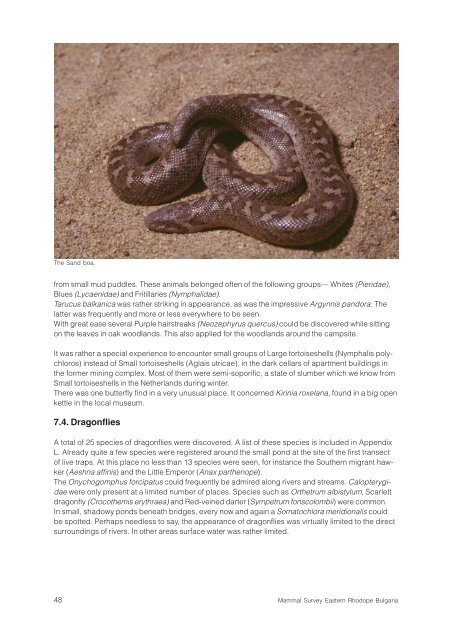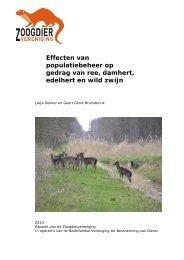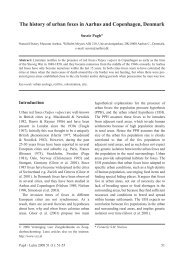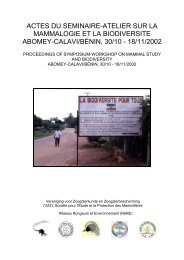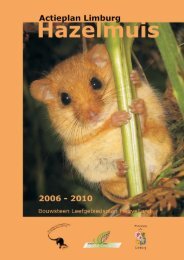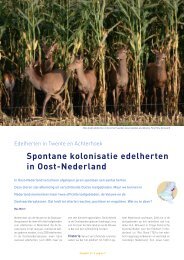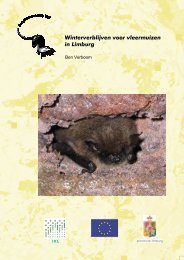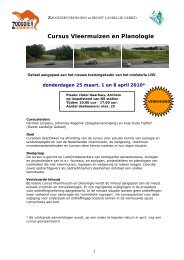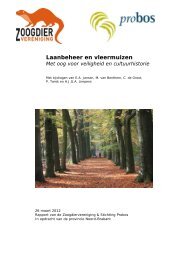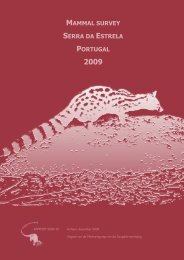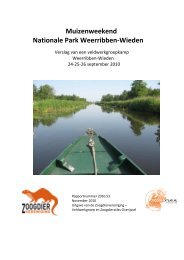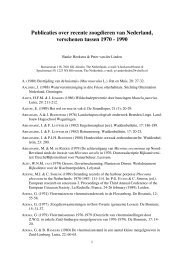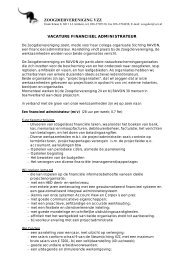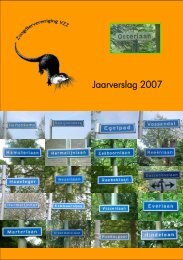The Sand boa.from small mud puddles. These animals belonged often of the following groups— Whites (Pieridae),Blues (Lycaenidae) and Fritillaries (Nymphalidae).Tarucus balkanica was rather striking in appearance, as was the impressive Argynnis pandora. Thelatter was frequently and more or less everywhere to be seen.With great ease several Purple hairstreaks (Neozephyrus quercus) could be discovered while sittingon the leaves in oak woodlands. This also applied for the woodlands around the campsite.It was rather a special experience to encounter small groups of Large tortoiseshells (Nymphalis polychloros)instead of Small tortoiseshells (Aglais utricae), in the dark cellars of apartment buildings inthe former mining complex. Most of them were semi-soporific, a state of slumber which we know fromSmall tortoiseshells in the Netherlands during winter.There was one butterfly find in a very unusual place. It concerned Kirinia roxelana, found in a big openkettle in the local museum.7.4. DragonfliesA total of 25 species of dragonflies were discovered. A list of these species is included in AppendixL. Already quite a few species were registered around the small pond at the site of the first transectof live traps. At this place no less than 13 species were seen, for instance the Southern migrant hawker(Aeshna affinis) and the Little Emperor (Anax parthenope).The Onychogomphus forcipatus could frequently be admired along rivers and streams. Calopterygidaewere only present at a limited number of places. Species such as Orthetrum albistylum, Scarlettdragonfly (Crocothemis erythraea) and Red-veined darter (Sympetrum fonscolombii) were common.In small, shadowy ponds beneath bridges, every now and again a Somatochlora meridionalis couldbe spotted. Perhaps needless to say, the appearance of dragonflies was virtually limited to the directsurroundings of rivers. In other areas surface water was rather limited.48 <strong>Mammal</strong> <strong>Survey</strong> <strong>Eastern</strong> Rhodope <strong>Bulgaria</strong>
8. ESTABLISHING A NATURE PARK8.1. HistoryAn idea for establishing a large protected nature area in the region of the Rhodope Mountains hasexisted for over 17 years. Proposals for such a reserve were presented for the first time in 1985, at anUNESCO Conference in Blagoevgrad, <strong>Bulgaria</strong>. Dr. Petar Iankov and Liubomir Profirov, two leadingornithologists in the country, addressed the conference on the needs and premises for the declarationof a “Nature park <strong>Eastern</strong> <strong>Rhodopes</strong>” in accordance with the legislation of the day. Over time, theproposed concept has not changed all that much — the establishment of a large protected area, witha “light regime” without constricting negative consequences for human activities in the area, but allowinga better natural resources management. However, in 1985 the existing information about floraand fauna in the region was not yet sufficient for the validation of the proposal to establish a new parkin the <strong>Eastern</strong> Rhodope Mountains.8.2. Research in the <strong>Eastern</strong> <strong>Rhodopes</strong>In 1993 – 1997 the <strong>Bulgaria</strong>n Society for Protection of Birds (BSBP) did preliminary research into thebiodiversity in the <strong>Eastern</strong> <strong>Rhodopes</strong>, aided by a Swiss government grant (<strong>Bulgaria</strong>n – Swiss BiodiversityConservation Programme BSBCP). The aims of this research were as follows.- Collecting more precise data regarding the diversity of plants and animals in the region- Clarifying the status of the populations of certain species with a high nature conservation status- <strong>De</strong>scribing and evaluating threats to biodiversity- Proposing measures for the preservation of biodiversity in the area.Some of the research continues until the present day, because until now only part of the whole areahas been studied (3 model areas of 400 square kilometres each). The results of these studies arevery promising. Many new species were recorded in the region — relict species and Rhodopean,<strong>Bulgaria</strong>n and Balkans endemic species.Brief summary of the results- Plants — 1994 high flora species, which is about 50% of the high flora species of <strong>Bulgaria</strong>.- Invertebrates — 1392 species recorded, but the expectations are for more than 3770 species.- Vertebrates — 392 species recorded. A total of 661 species are known to occur in <strong>Bulgaria</strong>, whichmeans that about 60% are present in this region.Of the recorded plants and animals, 49 species are mentioned in the Red List IUCN (2000), 364 areincluded in the Bern Convention, 357 species are protected by national <strong>Bulgaria</strong>n legislation and 202species are included in the <strong>Bulgaria</strong>n Red Data Book.8.3. Establishing a Nature ParkThe need to establish a Nature Park covering a large part of the area is obvious. The Nature Parkregime is one of the lightest levels of protection, corresponding to IUCN V category. Therefore, thestatus of the territory allows for human settlements, almost any kind of economic activity, forestry,agriculture and stockbreeding. Furthermore, the Nature Park status encourages nature-friendly economicdevelopment and sustainable use of natural resources by implementing various different judicialand financial tools, both on a national and an international scale. The Nature Park status also means amany-sided approach to the protection of species, habitats and landscapes, and it helps toward a coordinatedmanagement of the existing network of protected sites. Finally, the Nature Park statusshould reduce one of the main threats to the biodiversity in the region, i.e. mining activities.By the end of 1999, BSBP and BSBCP submitted a first proposal for the establishment of a NaturePark in the <strong>Eastern</strong> <strong>Rhodopes</strong> to the <strong>Bulgaria</strong>n Ministry of Environment and Waters. According to the<strong>Mammal</strong> <strong>Survey</strong> <strong>Eastern</strong> Rhodope <strong>Bulgaria</strong> 49


